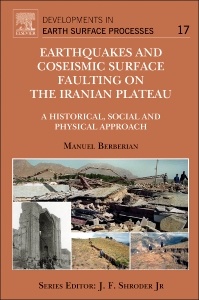Earthquakes and Coseismic Surface Faulting on the Iranian Plateau Developments in Earth Surface Processes Series
Auteur : Berberian Manuel

Earthquakes and Coseismic Surface Faulting on the Iranian Plateau is a comprehensive and well-illustrated multi-disciplinary research work that analyzes the human and physical aspects of the active faults and large-magnitude earthquakes since ancient times on the Iranian Plateau. The long-term historical, archaeological, and sociological record of earthquakes discussed here gives insight into earthquake magnitudes, recurrences, fault segmentation, clustering, and patterns of coseismic ruptures from prehistoric times to the present. The first part of the book examines oral traditions and literature of the region concerned with earthquakes, particularly in folklore, epic literature, and theology. The second part assesses dynamic phenomena associated with earthquakes, including active tectonics, archaeoseismicity, and coseismic surface faulting throughout the twentieth century.
This work is a valuable technical survey and an essential reference for understanding seismic hazard analysis and earthquake risk minimization in earthquake-prone developing and developed countries throughout the world.
PrefaceAcknowledgmentsIntroductionPart One: Earthquake Hazard Warning in Oral Tradition and Literature on the Iranian Plateau1. Place Names and Linguistic Traces Referring to Pre-Historic Earthquakes; Earthquake Hazard Warning in Oral Traditions2. Earthquake Myths3. Earthquakes and Religious Thoughts4. Ancient Earthquake Theories5. Earthquake Folklores and Legends6. Earthquakes in Epic Literature7. Earthquake Poems and Chronogrammatic Verses8. Earthquake Related InscriptionsPart Two: Dynamic Phenomena Associated with the Earthquakes on the Iranian Plateau9. Active Tectonics and Geologic Setting of the Iranian Plateau10. Archaeoseismicity11. Pre-1900 Coseismic Surface Faulting12. 1900-1963 Coseismic Surface Faulting13. 1964-1997 Coseismic Surface Faulting14. 1998-2013 Coseismic Surface Faulting15. Coseismic Blind-Fault Related Flexural-Slip Folding and Faulting at the Surface16. Patterns of the Historical Earthquake Ruptures on the Iranian Plateau17. Earthquake History of the Iranian PlateauReferences
Manuel Berberian was born on October 27, 1945 into an immigrant Armenian ethnic-religious minority in Tehran. He received a BSc degree in geology from the University of Tehran in 1968, and a PhD degree in earthquake seismology and active tectonics from the University of Cambridge, United Kingdom in June 1981. He was the first Armenian and the second Iranian earth scientist ever to be accepted at the University of Cambridge, UK. He is Emeritus Professor of Geosciences at the Tehran and Tarbiat Modarres Universities, and at present teaches at the Ocean County College, Toms River, NJ, USA. He is a certified professional geologist in the USA and a member of the New York Academy of Sciences and American Geophysical Union. He is a leading international earthquake expert on the Iranian Plateau and the Middle East. With his wife and son he immigrated to the USA in 1990.
He is a world renowned research scientist on seismotectonics, earthquake seismology, historical earthquakes, archaeoseismicity, palaeo- and active-tectonics, geology, and geologic hazards of the Iranian plateau, with 43 years of academic and research experience. He pioneered the study of plate tectonics and seismotectonics in Iran and was the founder of the ‘Tectonics and Seismotectonics Research Department’ of the Geological Survey of Iran in Tehran in 1971; the first research center established in this field in the Middle East. He has been a pioneer in the application of plate tectonics to Iranian geology and seismology, and has been responsible for much of what is known about the geology, tectonics, seismotectonics, archaeoseismicity, active faulting/folding, and seismicity of the Iranian Plateau, as well as human aspects of earthquakes, earthquake-fault hazard and risk assessment, and history and mythology of the ancient Iranian-Armenian ancient civilizations.
He has authored more than 300 reports and books; out of which about 110 research studies were published as peer reviewed papers in
- Provides a reference for seismic hazard evaluation and analysis
- Covers data dealing with crustal deformations caused by earthquake faulting and folding since historic times
- Presents unique and complete data for use in empirical relation analyses in all regions
Date de parution : 06-2014
Ouvrage de 776 p.
15x22.8 cm



